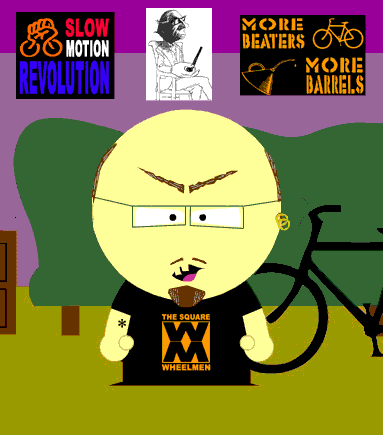Mea culpa %(
 I've been in Oregon ... Illinois ... over the last three days working with 40 Turkish and Greek high schoolers from Cyprus. You know: the place where the US Navy is dumping 20,000 American refugees from the new war between Lebanon and Israel. We were working on peace issues at the NIU Laredo Taft Field Campus. More on that later. I'm taking a nap...
I've been in Oregon ... Illinois ... over the last three days working with 40 Turkish and Greek high schoolers from Cyprus. You know: the place where the US Navy is dumping 20,000 American refugees from the new war between Lebanon and Israel. We were working on peace issues at the NIU Laredo Taft Field Campus. More on that later. I'm taking a nap... And in the meantime, a Chicago designer’s signage shows the benefits of bicycling over driving By Laurie Manfra from MetropolisMag.com on 17 April 2006.
And in the meantime, a Chicago designer’s signage shows the benefits of bicycling over driving By Laurie Manfra from MetropolisMag.com on 17 April 2006.A stretch of bike path leads through the verdant winding roads of Central Park then dumps you smack in the treacherous hustle of Midtown to fend for yourself. When it comes to creating bike-friendly routes, New York is clearly behind the curve despite recently being named the country’s third best biking city (with more than one million people) by Bicycling magazine. Chicago, on the other hand, has been working to implement the Bike 2015 Plan, Mayor Richard M. Daley’s third such initiative in the last decade and a half to promote safe and convenient cycling in the city.
Resident environmental designer Kimberly Viviano is taking advantage of that progressive agenda. “I was really impressed by the new bike station he commissioned for Millennium Park. It offers so much and made me realize that the mayor and I share similar goals,” she says. After meeting with several city agencies—including the Department of the Environment, the Department of Transportation, the Transit Authority, and the Chicagoland Bicycle Federation—Viviano is in talks with the city to install her signage comparing the personal and environmental benefits of bicycling to the pitfalls of driving (an exact installation date and location has yet to be set). Vinyl banners hung on lampposts in high-visibility areas where cars and bikes typically share the road—around the Loop, in the business district, and along the Magnificent Mile—will quantify differences between the two modes of transportation with compelling statistics, such as the cost of owning and maintaining a car ($9,964 per year) versus a bike ($68 per year).
Viviano’s signage was originally part of a proposal for a larger urban communication system titled “People Powered”—a runner-up in the 2005 Metropolis Next Generation Design Competition—which aimed to increase awareness of cyclists around the city and encourage more people to commute by bike. In addition to the signage, “People Powered” called for transparent billboards to frame cyclists, albeit briefly, along Lakeshore Drive so that gridlocked drivers might look on enviously at the self-propelled commuters breezing by them. She also proposed stenciling incentive messages such as “Independence from Fossil Fuels” on existing bike paths.
But the city’s reservations about installing more signs on Lakeshore Drive meant Viviano needed to modify her proposal. “It took a lot of tenacity,” she says. “I really had to keep forging ahead and adapting my proposal to their constraints, which were mostly monetary.” Viviano believes that the program she developed with the city’s input could serve as a role model for other cities. “Any public awareness campaign that is implemented by a city government is very powerful because it is backed by a reputable authority,” says Noah Budnick, projects director at the New York bicycle advocacy program Transportation Alternatives. “Putting dollars into a campaign like this helps others take the message seriously.” Perhaps before long New York agencies will take it seriously too.
Labels: Chicago, new urbanism, Our Bike Mayor, pax







0 Comments:
Post a Comment
<< Home